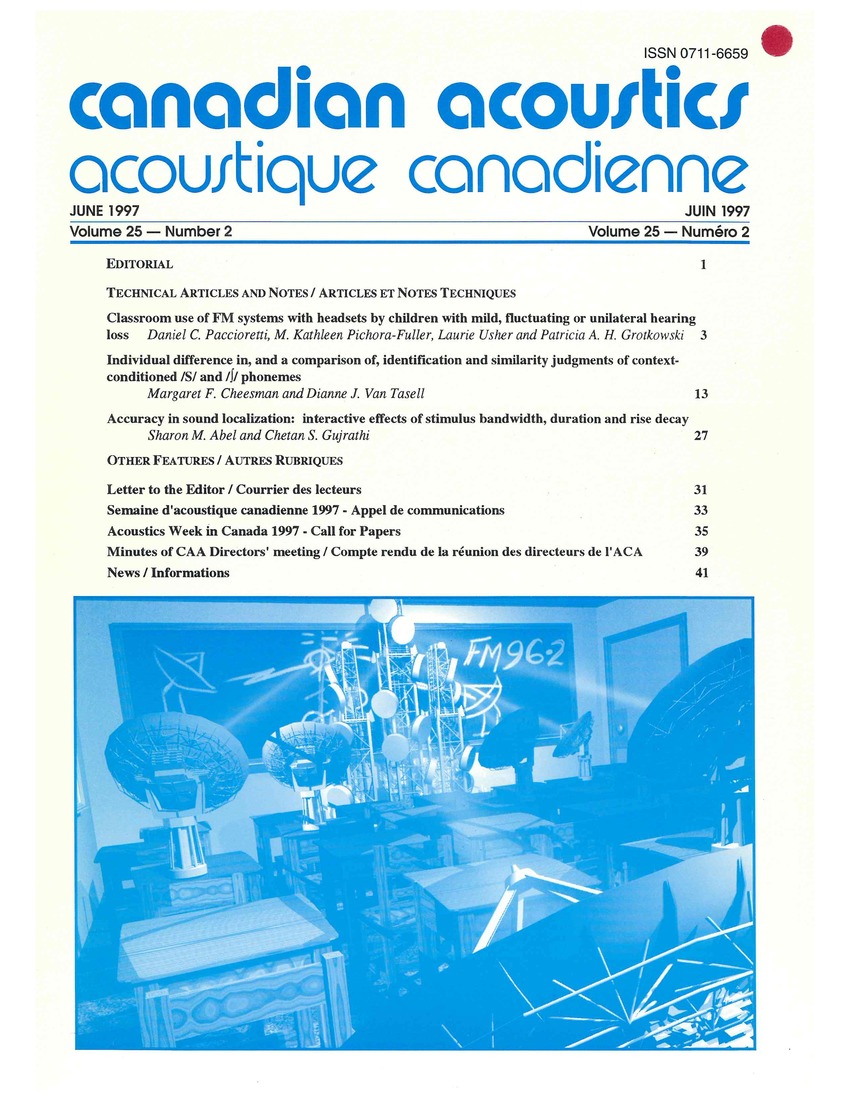Accuracy in sound localization: interactive effects of stimulus bandwidth, duration and rise decay
Keywords:
Acoustic noise, Acoustic waves, Bandwidth, Frequencies, Loudspeakers, Subjective testing, Precedence effect, Sound localization, Speaker identification, Stimulus duration, Stimulus rise decayAbstract
This study investigated the effects of stimulus bandwidth/centre frequency (broadband noise vs one-third octave bands, centred at 500 Hz and 4000 Hz), in interaction with stimulus duration/rise decay time (50/10, 300/10, 300/50 and 380/50 ms) on sound localization. The experiment was conducted in a semi-reverberant sound proof booth. Twelve normal-hearing subjects were tested using a single array of six loudspeakers positioned 60 deg apart in the horizontal plane. Each was presented one block of 120 forced-choice speaker identification trials for each for the twelve listening conditions. Subjects achieved 100% correct in localizing broadband noise, regardless of duration/rise decay. Scores were significantly lower for the one-third octave bands. There was no difference due to frequency for the three longer durations. For the short duration/short rise decay, a relative improvement was observed for the low frequency and a decrement for the high frequency. The results were interpreted with reference to the precedence effect.Additional Files
Published
How to Cite
Issue
Section
License
Author Licensing Addendum
This Licensing Addendum ("Addendum") is entered into between the undersigned Author(s) and Canadian Acoustics journal published by the Canadian Acoustical Association (hereinafter referred to as the "Publisher"). The Author(s) and the Publisher agree as follows:
-
Retained Rights: The Author(s) retain(s) the following rights:
- The right to reproduce, distribute, and publicly display the Work on the Author's personal website or the website of the Author's institution.
- The right to use the Work in the Author's teaching activities and presentations.
- The right to include the Work in a compilation for the Author's personal use, not for sale.
-
Grant of License: The Author(s) grant(s) to the Publisher a worldwide exclusive license to publish, reproduce, distribute, and display the Work in Canadian Acoustics and any other formats and media deemed appropriate by the Publisher.
-
Attribution: The Publisher agrees to include proper attribution to the Author(s) in all publications and reproductions of the Work.
-
No Conflict: This Addendum is intended to be in harmony with, and not in conflict with, the terms and conditions of the original agreement entered into between the Author(s) and the Publisher.
-
Copyright Clause: Copyright on articles is held by the Author(s). The corresponding Author has the right to grant on behalf of all Authors and does grant on behalf of all Authors, a worldwide exclusive license to the Publisher and its licensees in perpetuity, in all forms, formats, and media (whether known now or created in the future), including but not limited to the rights to publish, reproduce, distribute, display, store, translate, create adaptations, reprints, include within collections, and create summaries, extracts, and/or abstracts of the Contribution.


